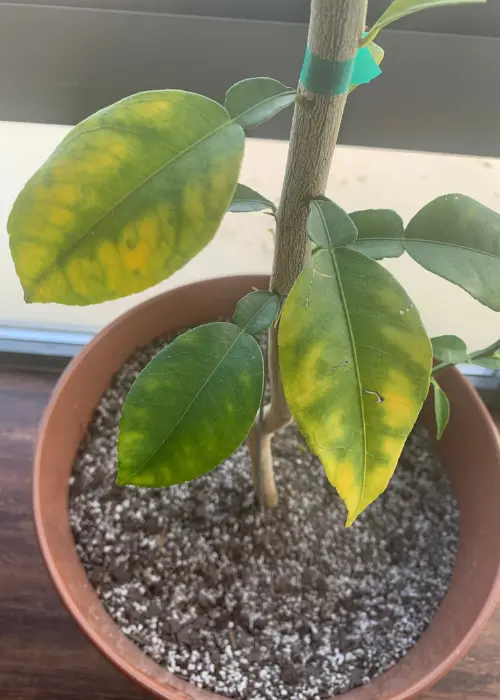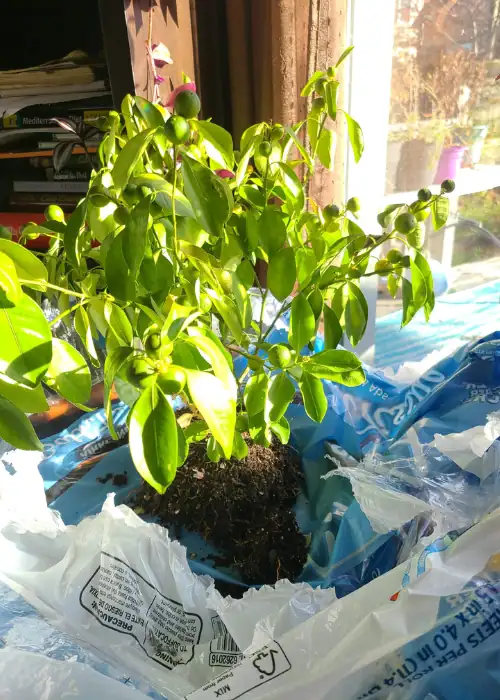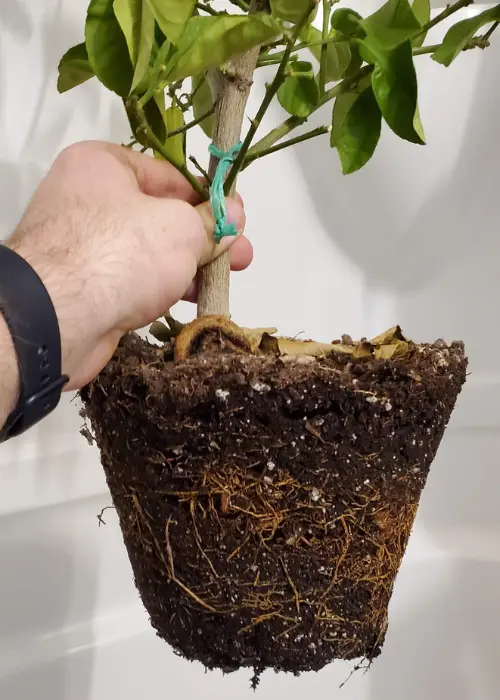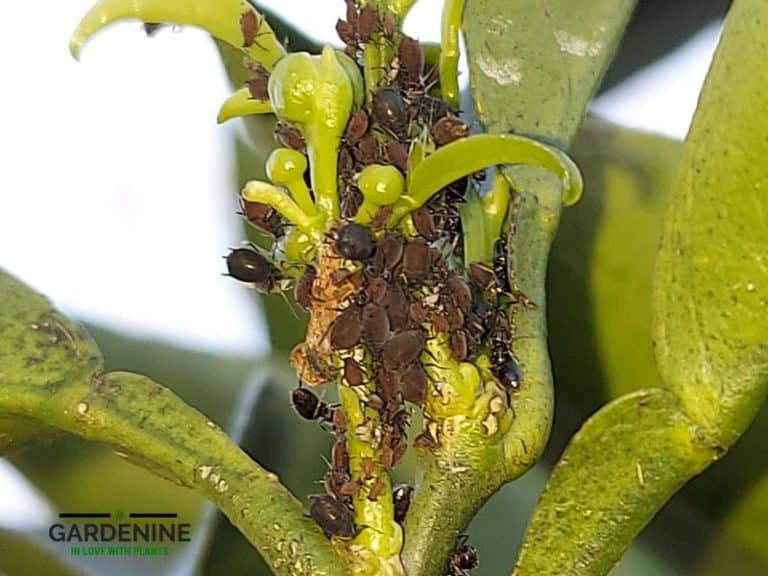Lemon Tree Root Rot – Expert Diagnosis and Treatment
As a certified master gardener with over a decade of hands-on experience growing lemons in containers and orchards, I’ve dealt with many instances of root rot disease in lemon trees. This silent killer, often detected when it’s too late, requires a keen eye to identify and treat.
Together with insights from other renowned gardening experts, we’ll delve deep into understanding root rot, its causes, symptoms, and, most importantly, how to treat your lemon tree and prevent the disease.

Understanding root rot
Root rot is a condition where the roots of a plant decay and deteriorate, often due to fungal infections. Phytophthora species is the main type of fungus that causes root rot disease. Since the infection happens in the root zone, which is beneath the soil, it can be difficult to notice its onset.
According to the Citrus Industry Magazine, “Phytophthora root rot damage begins below the soil, then extends through root systems. Declines in overall tree health happen rapidly, sometimes within a year under wet conditions.”
By the time the symptoms of root rot manifest above ground, the damage below is often extensive. The good news is that you can diagnose root rot and save the plant all by yourself.
The fungi responsible for root rot thrive in overly wet conditions, which is why we often warn against overwatering lemon trees.
The fungi invade the roots, cutting off or reducing the plant’s access to nutrients and water. As the roots decay, they become brown or black, turning mushy to the touch, a stark contrast to the firm, white, healthy roots we aim for.
Causes of Root Rot in Lemon Trees
As mentioned above, improper care, especially when it comes to watering, is the leading cause of root rot in potted plants. It is all about the conducive environment for the pathogen.

Several factors predispose lemon trees to root rot:
- Overwatering: Lemon trees prefer well-draining soil. Consistently wet soil creates an environment that encourages root rot fungi to flourish.
- Poor soil drainage: If you plant your citrus tree in water-retaining soil, you’ll often deal with root rot. Remember, soil can retain water due to its composition or compaction.
- Infected planting material: I’ve seen novice gardeners recycling old potting soil without sterilizing it. If you’re doing this, chances are you’re potting your lemon tree in a soil mix that’s already infested by fungi or other diseases. Also, infected saplings can introduce root rot fungi right from the outset.
- Lack of air circulation: Too dense or compacted soil is known to suffocate roots, making them prone to diseases.
- Planting lemon in a hole that’s too deep: Planting a citrus tree in a hole too deep and failing to fill it up will lead to water accumulation around the trunk, promoting fungal growth.
If you’re planting a lemon tree in the ground, I recommend digging a hole only as deep as the container it came in and even planting the tree slightly higher than the surrounding soil. This will prevent water from accumulating in the soil and posing the risk of root rot.
Identification and symptoms
An experienced plant care expert would identify root rot early enough, but it is common for beginners to miss out on the early symptoms.
Below are the signs and symptoms that can help identify root rot in lemon and other citrus trees:
Yellowing leaves
Yellow leaves can be a sign of various issues, but when combined with other symptoms listed here, it’s a major sign your plant has root rot.
Wilting
Despite adequate watering, a diseased lemon tree appears wilted, a sign that the roots aren’t effectively absorbing water.
Leaf drop
An affected tree may shed leaves prematurely, often starting with the older ones.
Mushy roots
If you gently unearth the soil around the base of a problematic plant and feel the roots, those affected by root rot will feel soft and mushy. We expect healthy lemon tree roots to have a firm texture.
A foul smell
Decaying roots emit a distinct, unpleasant odor, a sure sign of root rot. In spect the soil around your lemon tree to find out if there’s any unusual smell emanating from it.
Darkened bark at the base
The bark near the soil line might appear darker and feel easy to remove, even by light scratching. This is a sign of progressed root rot disease.
Diagnosing the root rot
Although the signs of root rot may be clear, we recommend checking to ensure the lemon tree has root rot. You can diagnose the tree by yourself, and here’s a simple guide for that:
- Visual inspection: Visually inspect the tree for the signs and symptoms of root rot discussed above. Changes in leaf color, droopiness, loss of leaves, and the condition of the bark at the base of the tree could point to root rot.
- Examine the soil: Carefully remove the soil around the base of the tree to expose a few roots. Healthy roots should be firm and white or light tan. If the roots appear dark, mushy, and emit a foul smell, it’s a clear indication of root rot.
Diagnosis and treatment should be done early enough to prevent loss of harvest in orchards. J. H. Graham of the University of Florida Extension says, “In advanced stages of decline, the production of new fibrous roots cannot keep pace with root death. The tree is unable to maintain adequate water and mineral uptake, and nutrient reserves in the root are depleted by the repeated fungal attacks.”
In a nutshell, inspecting the roots is the surest way to diagnose root rot. Soft roots that appear mushy, darkened, and break easily are a major sign of root rot.
How to treat root rot in lemon trees
If you discover the root rot early, there is a chance of saving the lemon tree.
Treatment for root rot in lemon trees involves removing the lemon tree from its pot, cutting off the rotting roots, applying an antifungal treatment on the remaining healthy roots, and finally repotting the plant in a fresh potting mix.

Here are detailed steps to save lemon trees with root rot:
- Prepare a new pot: Choose a pot with a few drainage holes and fill it with well-draining, sterile soil made for lemon and citrus trees.
- Remove the tree from the old pot: Gently remove the tree from its current pot, shaking off or washing the old soil from the roots.
- Trim the infected roots: Cut off any roots that are soft, brown, or black, which are signs of rot.
- Treat the remaining roots with a fungicide: Before repotting, treat the roots with a fungicide or a natural antifungal agent to prevent further infection. We prefer using a weak 3% hydrogen peroxide solution, but you can also use neem oil, Mefenoxam, or Fosetyl-Al if you’re growing lemon trees in the ground. These are highly effective against root rot fungi and can be applied as a soil drench to control the disease.
- Repot the tree: Place the tree in the new pot and fill it with fresh soil, ensuring it is planted at the same depth as in the old pot.
- Water the repotted tree: Water the tree lightly to settle the soil, but avoid waterlogging to prevent the recurrence of root rot. Water only after the top of the soil is dry.
Pace your potted lemon tree in a place where it will receive bright indirect light. After a few weeks, your lemon tree should recover and go back to the healthy plant it was.
Gardener’s note: To replant your lemon tree in a garden, choose a new location to avoid repeating the disease.
Prevention tips
Since root rot is not easy to spot, I always recommend prevention as opposed to dealing with the disease itself.
If you are planting your lemon trees in a garden, test your soil to see how quickly it drains water before planting your lemon tree. If your soil drains water slowly, add some gravel or sand to your soil to make it drain water fast.
If you plant your lemon tree in a pot, here are some of the simple tips that will ensure your plant’s roots stay healthy:
- Water your lemon tree evenly and regularly, but only when the top inch of soil dries out. Overly wet soil attracts and provides a conducive environment for water molds (Phytophthora) to thrive.
- Provide proper drainage. This is simple; I simply drill 4-6 holes in the planter to allow excess water to drain out of the pot.
- Planting Depth: Plant your trees at the right depth, avoiding too deep or too shallow planting, which can predispose the trees to root rot. Also, filling the hole with enough soil helps prevent flooding the hole with water.
- Aerate compacted soil. I prefer using soil amendments like compost and organic matter to improve soil structure and drainage.
Treat any infected trees early to save them. If the tree has no chance of surviving, I prefer taking some cuttings off it and propagating them into new plants.
Is it root rot or another disease?
Before attempting to treat your citrus trees, you may want to be sure the actual problem is root rot. Lemon trees can be affected by other diseases that may manifest similar symptoms to those of root rot.
Distinguishing between these diseases is essential for effective treatment:
- Citrus Canker: Symptoms include raised, corky lesions on leaves, fruits, and stems. Unlike root rot, it doesn’t affect the roots.
- Greasy Spot: This fungal disease causes yellow-brown lesions on leaves. It affects the tree’s leaves but doesn’t lead to root decay.
- Tristeza Virus: Leads to stunted growth and stem pitting. While it weakens the tree, it doesn’t cause root decay or the foul smell associated with root rot.
Takeaway: Root rot has distinct symptoms, primarily centered around the tree’s roots.
Read my complete guide on the identification of citrus diseases.
Conclusion
Root rot in lemon trees is a disease caused by fungal infections. Waterlogged soil and poor drainage are two conditions the create a conducive environment for phytophthora, the root-rot-causing pathogens. Soggy conditions also prevent roots from absorbing enough oxygen and nutrients.
Weakened roots are usually more vulnerable to soil fungus, which can cause root rot. The fungus may be present in the soil but remain dormant for long, making it hard to notice.
When the soil is waterlogged, the spores will revive and attack the roots causing them to rot and die.
The best fix for root rot is to ensure the soil is well-aerated, draining, and loose. Treat affected plants by unpotting them, washing the root ball, and cutting off decaying roots. Treat the remaining roots with a fungicide and repot the lemon trees in a well-drained potting mix.
This should save the plant.
Leave your comments below on what worked for you.





